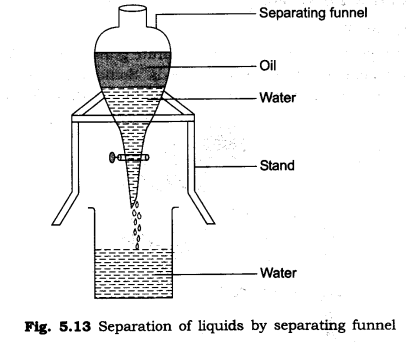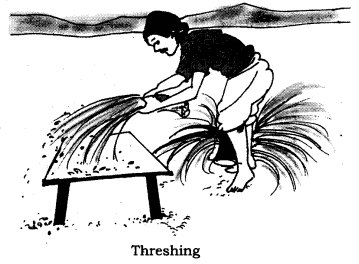Important Questions for Class 6 Science Chapter 5 Separation of Substances
Important Questions for Class 6 Science Chapter 5 Separation of Substances is given in this article. The answers of these important questions is prepared by our expert teachers as per the latest NCERT book and CBSE guidelines. Practicing these questions before the exam will help students to get excellent marks in the exam. Students can also download PDF of Class 6 Science Chapter 5 Separation of Substances important questions and answers from the links below.
Separation of Substances Class 6 Important Questions and Answers
Below we have complied the Class 6 Science Chapter 5 Separation of Substances important questions with answers. These important questions are divided into three parts. They are – Very short questions, short questions and long important question. CBSE important Questions for Class 6 Science will help to score more marks in your CBSE Board Exams.
Very Short Answer Type Questions
1. What is strainer?
Answer: Strainer is a kind of sieve which is used to separate a liquid from solid.
2. Name the method used to separate cream from curd.
Answer: Centrifugation.
3. How will you separate mango from a mixture of mango and apple?
Answer: By picking.
4. You are given a mixture of salt and sand. Can you separate them by picking?
Answer: No, we cannot separate them by picking.
5. Name the method used to separate the pieces of stone from grain.
Answer: Handpicking.
6. How can you separate grains from stalk?
Answer: We separate grains from stalk by threshing.
7. What types of material can we separate by using handpicking?
Answer: The materials having different size and colour can be separated by handpicking.
8. Name the other methods used to separate solid materials of different size.
Answer: Sieving.
9. Name the process used to separate heavier and lighter components of a mixture.
Answer: Winnowing.
10. Can the above stated method be used if both the components have same weight?
Answer: No, this method cannot be used.
11. What is evaporation?
Answer: The process of conversion of water into vapour is called evaporation.
12. Name the method by which we get salt from ocean water.
Answer: Evaporation.
13. Define condensation.
Answer: The process of conversion of water vapour into liquid form is called condensation.
14. Write opposite process of evaporation.
Answer: Condensation.
Short Answer Type Questions
1. What is mixture?
Answer: When two or more than two substances are mixed together in any ratio then it is called a mixture.
2. Write various methods of separation of components from their mixture.
Answer:
- Handpicking
- Threshing
- Winnowing
- Sedimentation
- Decantation
- Filtration
- Evaporation
- Condensation
3. Define the term handpicking.
Answer: The process used to separate slightly larger particles from a mixture by hand is called handpicking. For example: Stone pieces can be separated from wheat or rice by handpicking.
4. What do you mean by threshing? Where is it used?
Answer: Threshing is a process in which we separate grain from stalks. This process is used by farmer to separate gram, wheat, rice, mustard seeds in his field.
5. Write three methods of separation.
Answer: Handpicking, threshing and winnowing.
6. How will you separate oil and water from their mixture?
Answer: Oil, being lighter than water, will float on it. Two distinct layers are formed and slowly oil is allowed to flow into another container and is separated from water. Separating funnel can also be used to separate the two.

7. What is evaporation?
Answer: The process of conversion of water into vapour is called evaporation. This process takes place continuously where water is present. Common salt from sea water is obtained using this method.
8. Define winnowing.
Answer: The process is used to separate components from a mixture in which one component is heavier or lighter than other is called winnowing. Winnowing is done with the help of wind or by blowing air.
9. What do you mean by sieving? Give an example.
Answer: Sieving allows the fine flour particles to pass through the holes of the sieve while the bigger particles or impurities remain on the sieve. For example, in a flour mill, impurities like husk and stones are removed from wheat before grinding it.
Long Answer Type Questions
1. What is threshing?
Answer: Threshing is a process that is used to separate grain from stalks. In this process the stalks are beaten to free the grain seeds. Sometimes threshing is done with the help of bullocks. Machines are also used to thresh large quantities of grain.

2. Describe the method to obtain salt from sea water.
Answer: Sea water contains many salts mixed in it. One of them is common salt, when sea water is allowed to stand in shallow pits, water gets evaporated by sunlight and slowly turns into water vapour. In a few days, the water evaporates completely leaving behind the solid salts. Common salt is then obtained from this mixture of salts by further purification.
3. What is decantation?
Answer: Decantation is a process, of separation of insoluble solids from liquid. The suspension of solid particles in liquid is allowed to stand for some time. The solid particles then settle down at the bottom of the container and clean water goes up. Without disturbing the settled particles the clean water is transferred into other container.
4. Where is decantation used? Give two examples.
Answer:
(i) Decantation is used to separate insoluble solids or liquid from liquid. Rain water is a mixture of mud and water. It is purified by decantation.
(ii) Oil and water also get separated by this method because oil floats up.
5. How will you prepare cheese (paneer)?
Answer: For making paneer, a few drops of lemon juice sire added to milk as it boils. This gives a mixture of particles of solid paneer and liquid. The paneer is then separated by filtering the mixture through a fine cloth or strainer.
6. Explain the method that can be used for separating the following mixture:
(i) Sand and husk
(ii) Wheat, sugar and stalk
(iii) Water and petrol
(iv) Rice and salt
(v) Sand and salt
Answer:
(i) Mixture of sand and husk: Sand and husk can be separated by the method of winnowing.
(ii) Mixture of wheat, sugar and stalk: For separating stalk from the mixture we should follow the winnowing method because milk is lighter than other two components and get separated. Wheat and sugar can be separated by sieving because they are in different sizes.
(iii) Mixture of water and petrol: Water does not dissolve in petrol. So, it can be separated by the use of separating funnel.
(iv) Mixture of rice and salt: Rice and salt can be separated by sieving.
(v) Mixture of sand and salt: Sand and salt is mixed with water, salt dissolves in water and sand can be separated solution by sedimentation and decantation followed by filtration. After that using evaporation common salt is separated.